One day last month Alison Stanes, Chair of the Tāwharanui Open Sanctuary Society Inc (TOSSI) was at Tāwharanui monitoring New Zealand dotterels. During the course of the day she saw seven dotterel chicks near fledging, checked on a kaka chick that had fallen out of its nest to make sure that its parents were still feeding it on the ground and later in the day encountered a takahe chick.
“Tāwharanui is a very special place,” says Alison, who lives over an hour’s drive away in Auckland, yet has been a constant supporter. “I’ve been involved since 2002.”
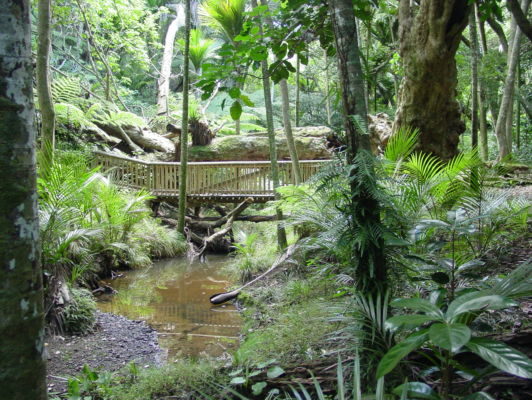
Tāwharanui Regional Park is located on a remote peninsula north of Auckland in the Hauraki Gulf. The 588 hectare park includes forest, wetlands and coastal dune habitats and adjoins a 400 hectare marine sanctuary.
It was New Zealand’s first open sanctuary, combining family recreation, conservation and farming. About 170 hectares is still farmed with sheep and cattle. TOSSI and the Auckland Council work together in the management and ecological restoration of the remainder of the sanctuary.
“Neither of the Council or TOSSI could have done what we have on our own,” says Alison. “We have the financial backing of the Council and for special budgets we match their funding. Working together is very special.”
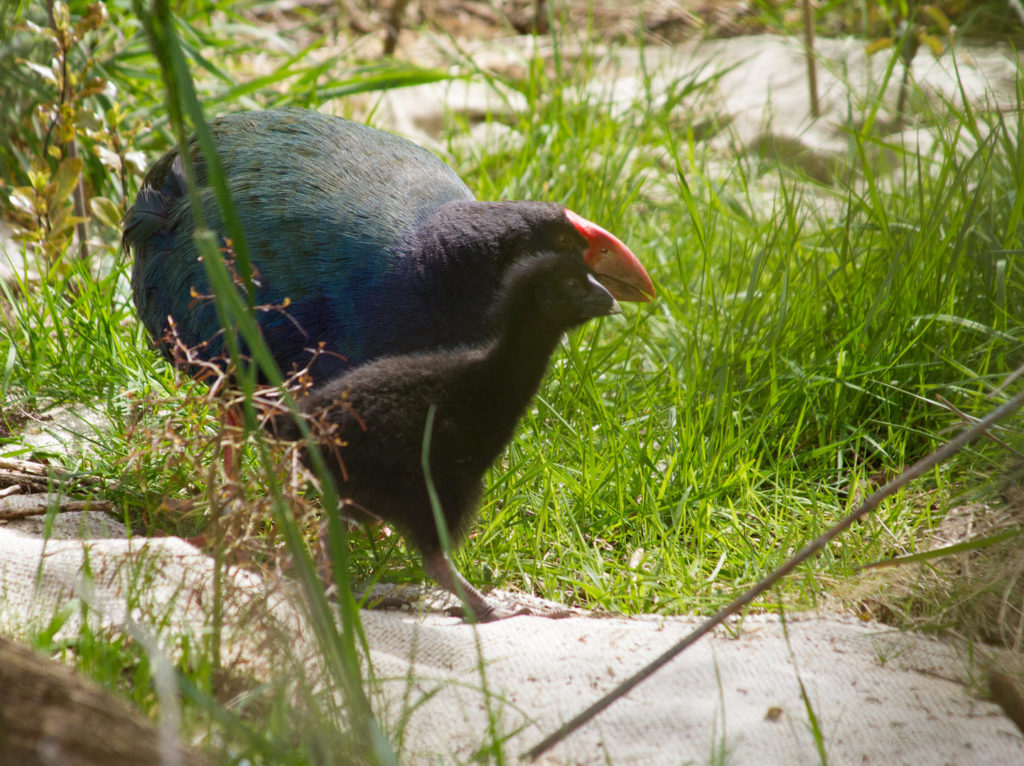
“The integrated activity – farming, recreation and conservation – is really important,” says Auckland Council Senior Ranger, Matt Maitland, who is responsible for both Tāwharanui and Shakespear open sanctuaries.
“It honours the reason why the park was originally acquired. For me, it’s also important in that it shows visitors what New Zealand could be like. It is creating a new normal,” he explains. “Visitors come and experience how noisy it is with the birds, then when they notice how quiet it is elsewhere they may wonder how and why.”
“I think it’s important for a predator-free future that we stop thinking of conservation as happening somewhere ‘other’ like predator-free islands” Matt says. “People can come for a day at the park. It’s a wonderful restoration.”
Alison agrees.
“A lot of people come for the surfing,” says Alison. “It’s a good beach for surfers as well as for beginner surfers. It’s a lovely family place. It’s also a wonderful example of what New Zealand could be like – the birdsong is absolutely astounding.”
“It’s an integrated landscape,” Matt explains. “We mustn’t fall into the trap of thinking that the pasture area is a negative. Kiwi, pateke and takahe all nest in the bush, but they graze in the pasture. It’s a useful part of the sanctuary.”
Surfers, cattle and takahe chicks may seem an unlikely mix – but the secret to the sanctuary’s success is its location on the remote Takatu Peninsula near Kawau Island. A predator-proof fence was erected on the sanctuary boundary back in 2004.
“Because it’s on a peninsula, the fence can be much shorter. A 2.5km fence encloses 588 hectares,” Alison explains.
“The peninsula location is a huge advantage,” agrees Matt. “By comparison, at Zealandia it takes 8.6km of fence to enclose 225 hectares.”
“But the fence isn’t into the sea,” Alison explains, “So there are leakages.”
“To our knowledge, the fence itself has never failed,” says Matt, “But the ends have leaked. And there are uncontrolled visitors, with a lot of people here at once on a good surfing day. There’s also camping at the park and we can’t check people’s belongings. The park gets 160,000 visitors per year.”
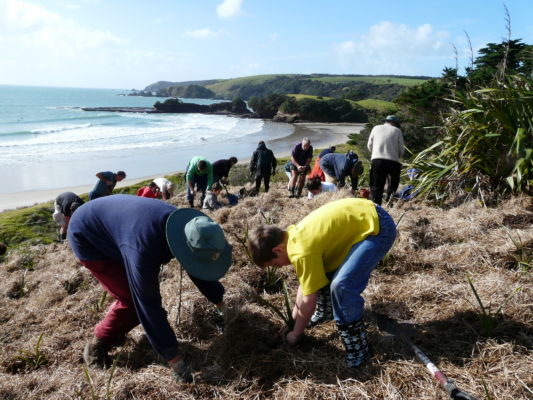
“There are tracking tunnels across the park and cameras that are checked regularly,” Alison says. “If there is an incursion, Auckland Council’s response is very quickly activated with tracker dogs and a lot of trapping. The tracker dogs are all trained for a specific species so there are dogs for rats, stoats, kiwi and pateke.”
“The actual incidence of pest incursions has been quite low,” says Matt, “And the known consequences are even lower. There has been some mangled wildlife, with puncture wounds characteristic of mustelids for example. But we’ve developed expertise in managing pest incursions. The first detection of a pest is usually finding it dead in a trap.”
To help reduce the chance of possible incursions, Matt and the TOSSI volunteers manage a buffer zone of predator control outside the fence. It serves several purposes.
“The buffer zone reduces the density of pests that could potentially find the ends or gaps in the fence,” Matt explains. “It also maximises the survival of birds that spread out from the sanctuary.”
TOSSI volunteers are involved in a variety of tasks at the sanctuary.
“Volunteer teams walk the length of the pest proof fence checking to make sure there are no leakages,” says Alison. “Teams monitor birds – grey-face petrel, New Zealand dotterel, takahe; a team helps the Auckland Council with trap lines and a Thursday group fix tracks and board walks. And on the first Sunday of the month we have a volunteer day where jobs are done right across the park and in winter this group organises the planting of 20,000 trees.”
Originally the whole of the Tāwharanui Regional Park was farmland and restoration planting of the wetlands and gullies is a big part of TOSSI’s ongoing volunteer work.
“We have a very strong nursery. A lot of retired people from Warkworth and Snell’s Beach volunteer. They’re very good at baking too,” Alison adds appreciatively. Good baking can do wonders for building an energised community spirit!
Weeding is another regular volunteer task at the park.
“We can get some terrible weeds,” says Alison. “Moth plant climbs to the top canopy and smothers it. Then the seeds go for miles. We have GPS sites that we check regularly, because the seeds can last in the soil for 20 years. Then there’s Asparagus scandens. It covers the understory. It lives in the shade and covers the nursery crop so there’s no regeneration.”
There’s always plenty of work to be done – but the reward for the volunteers is in the birdsong.
“Kaka and bellbirds have come back naturally,” says Alison. “North Island brown kiwi (2006/7), North Island robins (2007), whiteheads (2007), brown teal/pateke (2008-10), red-crowned parakeets (2009/10), North Island saddlebacks (2012) and takahe have all been translocated. The kiwi are prolific now. You don’t have to go far at night to see a kiwi.”
“The bellbirds came en masse from Hauturu/Little Barrier Island in 2005,” adds Matt. “Now they’re the most numerous bird in the park and they’ve spread out beyond the sanctuary.”
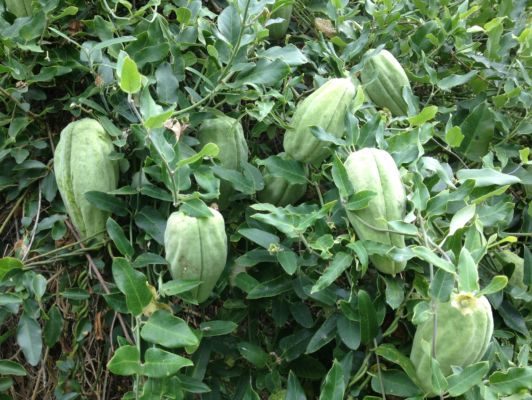
Green and forest geckos were translocated too (in 2005). Following the success of these geckos, Duvaucel’s gecko were reintroduced last year. Duvaucel’s gecko is New Zealand’s largest living gecko and one of the biggest geckos in the world. They can reach sizes of up 160mm snout-vent length and weigh up to 120g
“We have a 10-year reintroduction plan which is well researched,” Matt says. “We knew the other geckos were doing well and what conditions the Duvaucel’s gecko needed.”
Seabirds have begun returning too. Grey-faced petrels were confirmed to be breeding in the sanctuary in 2009 and common diving petrels in 2012. In the case of the grey-faced petrels, some noisy intervention was used to encourage their return.
“They nest in burrows and we played nesting calls at night at three sites,” says Alison. “Solar panels were used to drive the nesting calls and they were played very loudly! One passing yachtie thought there were howler monkeys on the peninsula!”
Fortunately Tāwharanui is a large peninsula. There are no close neighbours – so no callouts from ‘noise control’!
The loud intervention was a huge success and no-one was more excited at their return than Matt.
“My colleagues reckon it was the most excited they’ve ever seen me,” says Matt. “With the return of the seabirds, the biological potential of the site is unlocked. Seabird poo will restore a broken link.”
“This year 16 grey-faced petrel chicks fledged,” adds Alison. “They nest in a mix of natural burrows and man-made boxes which are inserted in the ground with a stormwater pipe entrance.”
The petrels are also banded.
“When the birds come in they make a call and land right beside you,” says Alison. They don’t have much fear of humans. Up to 30 or even more can be banded in an evening.”
The success of the work can be seen in the numbers of birds that are now spreading out into the wider surroundings.
“Kakariki and saddlebacks have both moved out. The latest pateke count showed there were even more pateke outside the sanctuary than in,” says Alison.
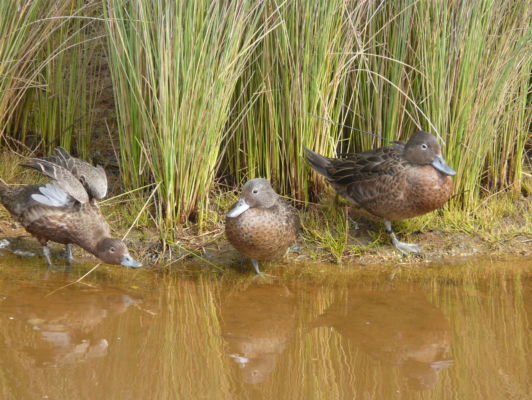
“At the last census, there were 144 pateke in the general district,” Matt confirms. “Only one third of those were in the park. We don’t know their breeding success outside the park, however.”
Whiteheads and kakariki have spread out as well. Robins go outside the sanctuary, but they don’t yet have the numbers to establish outside.
“Saddlebacks go out too,” says Matt, “But they don’t survive. Their behaviour is against them. People forget that the saddleback went extinct on mainland New Zealand before the huia did.”
The outflow of native birds is encouraging the park’s neighbouring landholders to get involved in conservation themselves which is exactly what Alison and Matt want to happen.
“We want social and ecological contagion beyond the fence,” says Matt.
“There’s a landcare group next door that is now getting heavily into pest control,” Alison adds.
That’s good news for Tāwharanui’s expanding bird population as they venture into the wider, not-so-predator-free world. If more of the peninsula’s neighbours get involved, maybe one day Tāwharanui’s saddlebacks will survive outside the sanctuary too.

